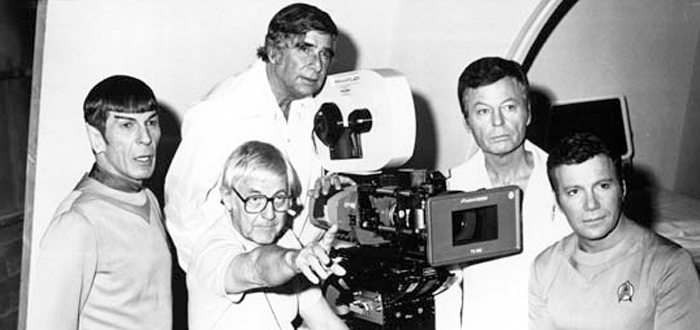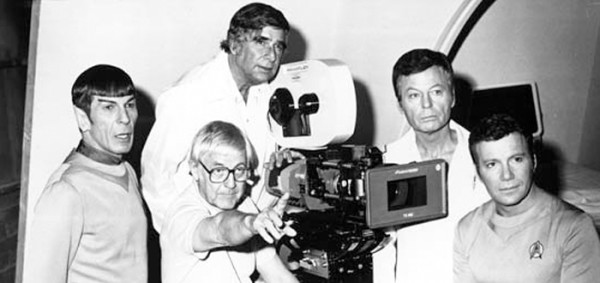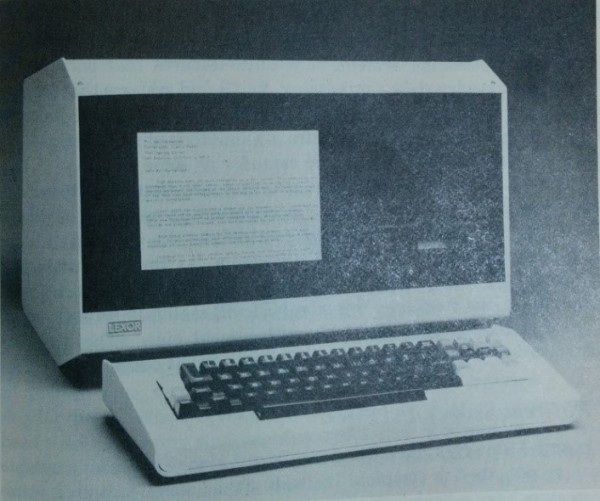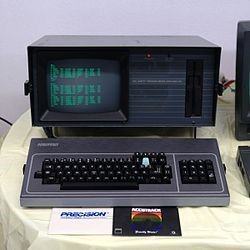

Gene was a producer and writer. Writing tools have changed over the years from simple pen and paper, the mechanical typewriter, the electric typewriter to word processing on computers—all of which everyone handled at the time. Certainly a guy like him is no stranger to computers. Indirectly, he’s responsible for many technological innovations inspired by Star Trek like mobile phones and tablet computers. Yes, Gene used floppies which were as ubiquitous back then as USB sticks are now. By the way, USB sticks are somewhat equivalent to Star Trek: The Next Generation’s isolinear rods. But at the time, floppy disks were the main storage medium and for the young whippersnappers reading this, the data of hundreds of those disks Gene used could fit in your throwaway 4GB USB stick.
Gene used a generic looking computer to write his pieces. It looked so generic that it took a while to identify. It was a white box with a monitor with two integrated full-sized floppy disk drives. It used the Zilog Z-80 processor, had 64K of RAM and was run using the CP/M operating system (the precursor to MS/DOS). It was thought at first to be an IBM PC variant, but it was later identified to be a Lexoriter from Luxor systems. Gene had two of them which he used at the office as nothing more than a ‘glorified typewriter’ as per his longtime assistant Susan Sackett. Gene Roddenberry also owned a KayPro 10 as well as a Macintosh given to him by Apple in 1986.


So Star Trek creator Gene Roddenberry thought of his computer as a simple writing tool. No code was written, nor did he probably have time playing Oregon Trail on it. He used it to format his disks and fill them with scripts, notes and messages. The mystery now is, what were in those disks?
“Sorry to disappoint, but there are no long-lost Star Trek episodes on the disks! I can’t recall specifics, but it would be mostly correspondence, speeches, and script ideas…He used them mainly for writing and re-writing his Star Trek II novel, which was never published, as well as the script which was never filmed, and for his speeches and general rewrites…”
–Susan Sackett, Assistant to Gene Roddenberry, interview with PCWorld
But she’s not 100 percent on all the contents. The Roddenberry estate has opted for the contents to remain confidential probably until CBS or Paramount chooses to obtain anything commercially viable.
As Gene’s Lexoriter wasn’t functional, retrieving the data in Gene’s 200 old floppy disks became a serious task which fell to a data recovery company in California called DriveSavers Inc. The computer’s generic nature made determining the disks’ format uncertain and the lack of an identical working computer didn’t help. The disks were mostly 5.25-inch double density disks which store 160KB (kilobytes) each. Yes, the soft ones. Also, the CP/M operating system allowed the users to format their disks in a variety of ways, so Drivesavers had to determine how the disk was formatted and how the data was written.
“The older disks, we had to actually figure out how to physically read them… The difficult part was CP/M and the file system itself and how it was written…”
–Mike Cobb, Director of Engineering, DriveSavers
DriveSavers managed to recover 95 percent of the data in all the disks which totaled to about 3MB of data composed of text files. It doesn’t seem much, but in pure text form, that’s more than a hundred ten-page files. There should be a couple of gems there somewhere. Aside from Susan Sackett’s comments on the contents, Gene’s lost words is anybody’s guess. The contents could spell the revival of Gene’s vision of Star Trek, perhaps a new cop series based on The Lieutenant and Highway Patrol and a remake of Pretty Maids All in a Row. Some of Gene’s notes were used to create Andromeda and Earth: Final Conflict.

